It looks like you're using an Ad Blocker.
Please white-list or disable AboveTopSecret.com in your ad-blocking tool.
Thank you.
Some features of ATS will be disabled while you continue to use an ad-blocker.
share:
This does not address the issue of different physiology on another planet, does not address the point I made which is that there could be non-chlorophyl containing plants on Mars which may not be green.
No, just that it would help to distinguish different materials.
You will look at a non-green plant and tell us that it is a rock because it is not green. Thats absolutely ridiculous. We just dont know what these plants are made of or how they process light or even IF they process light. You cannot possibly look at a colour photo and tell me this is rock this is plant, or this is alive, or this is not alive.
You are making fundemental assumptions you just cannot make.
How would it help distinguish different materials?
edit on 17 Aug 2013 by qmantoo because: (no reason given)
Further ideas of what this could be are lichens or slime mold examples from here on Earth. Although the slime mold shown is mostly found on trees,
there are probebly others which prefer rocks. The structure of the lichen looks very similar to the image in the first post.
Lichen section (2nd item) looks very similar
Henderson State University
Lichen section (2nd item) looks very similar
Lichens, of which 15,000 species are known to science, have scientific names as though each is a species of organism, but actually a lichen is comprised of a fungus and an alga supposedly living in a symbiotic relationship (both are benefited by living together.) The fungus cannot photosynthesize so it cannot create food from solar energy, but the alga can photosynthesize.
Henderson State University
One common and brightly colored slime mold is known as “Wolf’s Milk” or “Pink Toothpaste” slime mold (Lycogala epidendrum). Often it is misidentified as a pink-colored puffball, although each individual is much smaller (usually under one cm, or 3/8 inch in width) than most fungal puffballs. When these pink spherical blobs are punctured, a pinkish slime often will squirt out, reminiscent of pink toothpaste. This slime mold is found typically on the side or top of large fallen trees.
qmantoo
This does not address the issue of different physiology on another planet, does not address the point I made which is that there could be non-chlorophyl containing plants on Mars which may not be green.
No, it does not, but it doesn't need to, I can address one point at a time.
You will look at a non-green plant and tell us that it is a rock because it is not green.
That's just silly and it shows that you have a very wrong idea about me and about plants in general.
And you are wrong in that chlorophyll=green idea, as many chlorophyll containing plants are not green, the red cabbage being an example of a plant that changes colour according to the acidity of the soil.
Thats absolutely ridiculous.
No, your idea that you know what I think is ridiculous.
You cannot possibly look at a colour photo and tell me this is rock this is plant, or this is alive, or this is not alive.
When you read someone's answer you should try to understand what they say instead of "massaging" what they wrote to make it fit what you think about them or the subject being discussed.
You are making fundemental assumptions you just cannot make.
No, you are making fundamental (with an "a") assumptions about what I think, and you are failing.
How would it help distinguish different materials?
Different materials that have different colours instead of different materials that have different colours that look similar when seen in greyscale, specially if in just one short wavelength "window".
qmantoo
Further ideas of what this could be are lichens or slime mold examples from here on Earth. Although the slime mold shown is mostly found on trees, there are probebly others which prefer rocks.
They would prefer rocks if they could find their food on rocks, that's why they are usually found on trees.
And although that image looks similar to the one on the first page, it also has several differences, like looking smooth and with a kind of skin covering it, while those on the image from the first page do not.
Originally posted by qmantoo
This does not address the issue of different physiology on another planet, does not address the point I made which is that there could be non-chlorophyl containing plants on Mars which may not be green.
No, just that it would help to distinguish different materials.
You will look at a non-green plant and tell us that it is a rock because it is not green. Thats absolutely ridiculous. We just dont know what these plants are made of or how they process light or even IF they process light. You cannot possibly look at a colour photo and tell me this is rock this is plant, or this is alive, or this is not alive.
You are making fundemental assumptions you just cannot make.
How would it help distinguish different materials?edit on 17 Aug 2013 by qmantoo because: (no reason given)
I never said that it had to be green. You're making an assumption about how I and others think. You are concluding something that may or may not be true: IE because they want color pictures, they must think that all plants need to be green.
For all I know, if there are plants on Mars, they might look yellow. Or brown. Or blue. Or purple.
I never said that a plant MUST have green in it and use chlorophyl to get energy. Never did I say that.
You are assuming that if we look at something that might not be a rock, we'll call it a rock because it's not green.
Excuse me, but exactly at what point did you get the ability to read mine and other's minds?
Your assumptions about us are just as bad as the assumptions you are claiming we'll make.
Color helps. Period.
One of these objects is red, and one is blue. Which is which?

The one on the right is red. But because it's a black and white (grey scaled) picture: you have no way of knowing that by looking at the picture itself when it's in this state.
However, a COLOR photo, shows us the difference, and can help in showing that they are different materials:
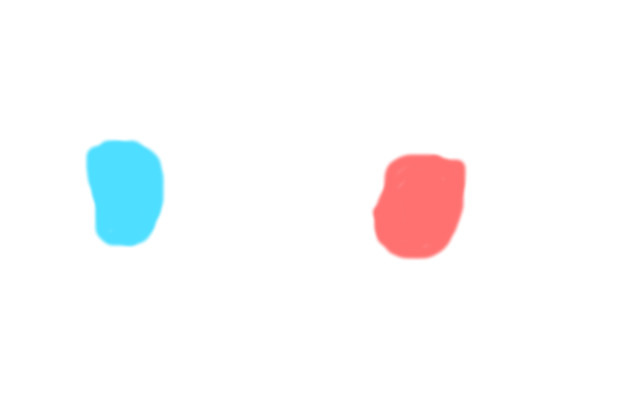
Is it a plant or not? I have no way of telling right now with just the color photo either. However, I can tell you that the blue object must be some other kind of material than the red object.
This is a more extreme example, as both colours have the same lightness.
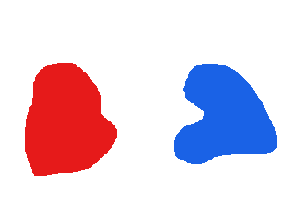
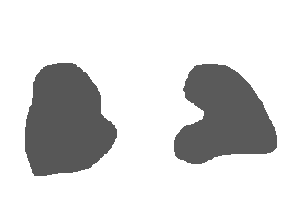


But, having said all of the above, now that I looked better at the photo, it sure looks like there's some kind of fiber-like object there.
Is it animal, plant or mineral? I don't have the slightest idea, and judging just by the shape of the object is the same as judge just by the colour, we need more data to make a better judgement.
Edit: but we should not forget that the area where that object (if it is an object) is was compressed by the RAT before the photo was taken.
Is it animal, plant or mineral? I don't have the slightest idea, and judging just by the shape of the object is the same as judge just by the colour, we need more data to make a better judgement.
Edit: but we should not forget that the area where that object (if it is an object) is was compressed by the RAT before the photo was taken.
edit on 17/8/2013 by ArMaP because: look above
ArMap in this post
So, instead of getting all huffy about it, may be you can tell us what colour would tell us? (Apart from being different materials which I have covered below and is not always true)
Erik
No, how would they do that? As we have all pointed out, how would we know what colours represent plant and what colours represent minerals? It seems like you are assuming mineral accretion can be identified by colour? (que the hasty backtrack...)
ArMap
One coloured item may be a red leaf, one might be a blue flower of the same plant. That would not tell us anything except that they were different items (leaf/flower). Both are the from the same plant in this example case. This is the kind of thinking which we may have to modify when viewing other-worldly images. Pointsettia has both red and green leaves on the same plant. (and I dont care if I have spelt it wrong)
ArMap
I was the one who said that green does NOT equal chlorophyl/plant life. What have I got wrong about plants in general?
Here you are suggesting that we may be looking at aggregated dust. But I asked what colour would tell us? Then I went on to explain that people would assume plant life was green and not any other colour which was not correct in an off-world environment.
There are other photos in which we can see that the dust acts almost as if it was wet, with a great tendency to aggregate. Too bad we don't have colour.
So, instead of getting all huffy about it, may be you can tell us what colour would tell us? (Apart from being different materials which I have covered below and is not always true)
I was obviously trying to understand what you were saying by wishing that we had colour images of this. Obviously I got it wrong so what were you saying?
I think you are saying that if the plank-like thing was green, it would add weight to the argument and if it was red it would add weight to the aggregated dust hypothesis?
Erik
Because certain minerals have certain colors. Doesn't mater what planet they are on.
A true color photo might allow us to either point out it's a mineral accretion of some sort, or possibly dust.
Or, it could help further your evidence that it is neither and might indeed be some form of life.
Don't knock the colors. They can help in many ways.
No, how would they do that? As we have all pointed out, how would we know what colours represent plant and what colours represent minerals? It seems like you are assuming mineral accretion can be identified by colour? (que the hasty backtrack...)
ArMap
It would certainly lead some of us to conclude that red and blue coloured items may be made of different material. If you think that, then maybe you are making assumptions which should not be made in this case.
No, just that it would help to distinguish different materials.
One coloured item may be a red leaf, one might be a blue flower of the same plant. That would not tell us anything except that they were different items (leaf/flower). Both are the from the same plant in this example case. This is the kind of thinking which we may have to modify when viewing other-worldly images. Pointsettia has both red and green leaves on the same plant. (and I dont care if I have spelt it wrong)
OK, then let me ask you this. How do we know the dust acts exactly the same way as it does on Earth? Some dust may reflect and refract differently depending on the size and composition of the particles. There are so many atmospheric phenomena here on Earth which alter the light from rainbows to sun dogs. This is possibly another unknown which we have not figured out yet. Like I said, maybe the 'index colours' on the joystick have become faded and are now unlike they were at the start of the mission. What are we to use as reference now then?
From the photos we have seen, the dust acts like a filter (exactly in the same way as on Earth) and the light becomes that reddish brown.
ArMap
No good you telling me that. Who is being silly now?
That's just silly and it shows that you have a very wrong idea about me and about plants in general.
And you are wrong in that chlorophyll=green idea, as many chlorophyll containing plants are not green, the red cabbage being an example of a plant that changes colour according to the acidity of the soil.
I was the one who said that green does NOT equal chlorophyl/plant life. What have I got wrong about plants in general?
qmantoo
So, instead of getting all huffy about it, may be you can tell us what colour would tell us? (Apart from being different materials which I have covered below and is not always true)
Colour, being just one property, is not enough to tell us that, that's why I said it would help.
I was obviously trying to understand what you were saying by wishing that we had colour images of this. Obviously I got it wrong so what were you saying?
Exactly what I said, that it would help.
It would certainly lead some of us to conclude that red and blue coloured items may be made of different material. If you think that, then maybe you are making assumptions which should not be made in this case.
Like you said, it may mean that they were different materials, one property is not enough to identify any thing.
OK, then let me ask you this. How do we know the dust acts exactly the same way as it does on Earth?
We know (as far as we can without really being there) because the cameras are calibrated on Earth and then re-calibrated on Mars, so they know the differences (if any) between one situation and the other, regardless of the dust reacting in the same way or not.
There are so many atmospheric phenomena here on Earth which alter the light from rainbows to sun dogs.
That's different, those are events that are only visible from somewhere else (that's why we can never be at the end of a rainbow), while dust in the air, like in a dust storm, affects the area where the camera is and acts like a filter in front of a light source. Where I live we had once the remains of a North Africa dust storm turning everything reddish and covering everything with an extremely fine dust.
This is possibly another unknown which we have not figured out yet. Like I said, maybe the 'index colours' on the joystick have become faded and are now unlike they were at the start of the mission. What are we to use as reference now then?
I doubt that the colours have faded all the same, and that would be the only way of not being noticed.
I was the one who said that green does NOT equal chlorophyl/plant life. What have I got wrong about plants in general?
Then I misinterpreted what you wrote. Ignore that part about chlorophyll/plant life.
This is not worth arguing over but
Ok, so Mars is further from the sun and there is so much red dust in the atmosphere, that it could not possibly sun-bleach the reference colours on the joystick. However, there is probably more radiation at the surface due to the thin atmosphere.
Any colours left out in the sun get bleached out. If you dont have linings to your curtains in a south or west facing window, then they will become faded. Have you never seen this?
I doubt that the colours have faded all the same, and that would be the only way of not being noticed.
Ok, so Mars is further from the sun and there is so much red dust in the atmosphere, that it could not possibly sun-bleach the reference colours on the joystick. However, there is probably more radiation at the surface due to the thin atmosphere.
Originally posted by qmantoo
This is not worth arguing over but
Any colours left out in the sun get bleached out. If you dont have linings to your curtains in a south or west facing window, then they will become faded. Have you never seen this?
I doubt that the colours have faded all the same, and that would be the only way of not being noticed.
Ok, so Mars is further from the sun and there is so much red dust in the atmosphere, that it could not possibly sun-bleach the reference colours on the joystick. However, there is probably more radiation at the surface due to the thin atmosphere.
Depending upon what materials were used to make the color reference will depend also on how long they take to bleach. Certain materials take a lot longer to sun bleach than others.
If you look at the pictures coming from Curiosity, you'll notice that almost every Sol they take images of the color reference. They can then compare those images to the ones taken when Curiosity first got there and see / compensate for sun bleaching.
qmantoo
Any colours left out in the sun get bleached out. If you dont have linings to your curtains in a south or west facing window, then they will become faded. Have you never seen this?
Not all colours get bleached, the permanent pigments are not altered by the light (usually is the UV light), that's how you can have buildings painted in some colour and the colour doesn't change.
And no, I don't have curtains at home.
Ok, so Mars is further from the sun and there is so much red dust in the atmosphere, that it could not possibly sun-bleach the reference colours on the joystick. However, there is probably more radiation at the surface due to the thin atmosphere.
I think Curiosity has an instrument to measure the radiation.
PS: does the red dust get bleached?
I looked for more photos of that area and found some taken from slightly different places, so I tried to make a 3D version.
First, an animated GIF.
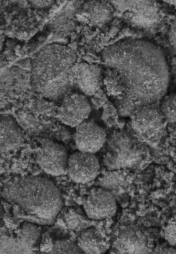
A "cross eye" version.
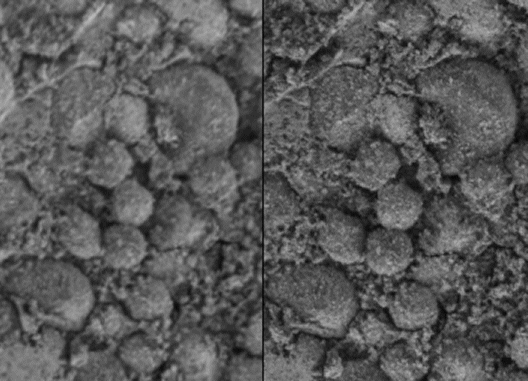
And a red/blue anaglyph, for those with the red/blue glasses.
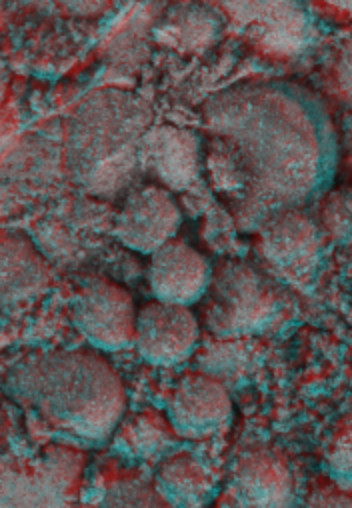
I hope it helps.
First, an animated GIF.

A "cross eye" version.

And a red/blue anaglyph, for those with the red/blue glasses.

I hope it helps.
ArMaP
Yes, it does help. Thanks. The anaglyph looks to me as it the plant-like thing is sticking up towards the camera. Still could be anything other than a mineral vein though. To me it does look plant-like and I think there should be enough curiousity for NASA scientists to investigate further. If they wanted to of course.
What does it look like to you ArMaP? You did not say anything and I was hoping for a comment on what you saw perhaps.
Yes, it does help. Thanks. The anaglyph looks to me as it the plant-like thing is sticking up towards the camera. Still could be anything other than a mineral vein though. To me it does look plant-like and I think there should be enough curiousity for NASA scientists to investigate further. If they wanted to of course.
What does it look like to you ArMaP? You did not say anything and I was hoping for a comment on what you saw perhaps.
qmantoo
The anaglyph looks to me as it the plant-like thing is sticking up towards the camera.
That's how I see it too.
What does it look like to you ArMaP? You did not say anything and I was hoping for a comment on what you saw perhaps.
I don't know.
Considering that that area was compressed by the RAT, I doubt it was a living organism, as it doesn't show any signs of reaction (a characteristic of all the living organisms I know) to that relatively violent action, so I suppose it could be just some aggregated dust.
Also, it's near the edge of the compressed area, the most likely area to have some "artefacts" resulting from the compression.
Considering that that area was compressed by the RAT, I doubt it was a living organism, as it doesn't show any signs of reaction (a characteristic of all the living organisms I know) to that relatively violent action, so I suppose it could be just some aggregated dust.
Also, it's near the edge of the compressed area, the most likely area to have some "artefacts" resulting from the compression.
I dont see how we would notice any signs of a reaction? It is not large enough to 'spring back up' much after being compressed. What kind of reaction would you be looking for? The only reaction such a small organism might have is to be squashed and then it would not look like anything but mashed-up pieces as they other RAT images show all around the edges.
It could be aggregated dust, but I have shown other examples (at least 2x other examples) where a similar shape occurs which is unllikely if it were to be aggregated dust. You seem to be ignoring the other examples I gave of 'Y'-shaped things, although I do recognise that that 'y'-shapes are fairly common in nature - leaves, branches, mineral veins in rocks.
A young plant does produce the leaves first and they are in the shape of a 'Y', so it would make sense to have this shape if it was anything like Earth. I have also pointed to simple plants like mosses and lichens which look like this shape we are seeing here.
Your images above are really useful to add to this thread suggestion that we may have found plant life. I will hunt for other examples in MI images.
qmantoo
The only reaction such a small organism might have is to be squashed and then it would not look like anything but mashed-up pieces as they other RAT images show all around the edges.
That's the kind of reaction I would expect, but the squashed plant would look different from a pulverized rock or some aggregate dust.
You seem to be ignoring the other examples I gave of 'Y'-shaped things, although I do recognise that that 'y'-shapes are fairly common in nature - leaves, branches, mineral veins in rocks.
Not ignoring them, forgetting about them.
I will look again.
Your images above are really useful to add to this thread suggestion that we may have found plant life. I will hunt for other examples in MI images.
Don't forget, whenever we have two images from slightly different positions we can make a 3D image of the area that appears in both.
I will look for other plant-like structures but they are very small and there are a lot of MI images. :-) Until then, this thread will have to
sink...
I dont think that ANY evidence will be good enough from ANY of the Mars images, however much there is. Until NASA are good and ready to disclose something they will continue with their control program.
I dont think that ANY evidence will be good enough from ANY of the Mars images, however much there is. Until NASA are good and ready to disclose something they will continue with their control program.
new topics
-
President-elect TRUMP Picks MATT GAETZ for his ATTORNEY GENERAL - High Level PANIC Ensues.
2024 Elections: 3 minutes ago -
Mike Tyson returns 11-15-24
World Sports: 4 hours ago -
HHS Spent Hundreds of Millions of Dollars on DEI Initiatives Under Biden, Watchdog Finds
US Political Madness: 5 hours ago -
Breaking: FBI Agents Raid Polymarket CEO After Betting Site Predicts Trump Win
General Conspiracies: 5 hours ago -
The Guardian quits Elon Musk's X social media platform
Mainstream News: 6 hours ago -
Thune selected as Senate Republican Leader
US Political Madness: 9 hours ago -
Band of Brothers 2001 Classic
Television: 9 hours ago -
US warship Edsall Lost after Pearl Harbor Attack Found 80 Years Later ... by Accident
Mainstream News: 9 hours ago -
WATCH LIVE: US Congress hearing on UFOs, unidentified anomalous phenomena
Aliens and UFOs: 11 hours ago
top topics
-
Breaking: FBI Agents Raid Polymarket CEO After Betting Site Predicts Trump Win
General Conspiracies: 5 hours ago, 18 flags -
How can you defend yourself when the police will not tell you what you did?
Posse Comitatus: 16 hours ago, 17 flags -
The Guardian quits Elon Musk's X social media platform
Mainstream News: 6 hours ago, 15 flags -
Thune selected as Senate Republican Leader
US Political Madness: 9 hours ago, 13 flags -
US warship Edsall Lost after Pearl Harbor Attack Found 80 Years Later ... by Accident
Mainstream News: 9 hours ago, 13 flags -
HHS Spent Hundreds of Millions of Dollars on DEI Initiatives Under Biden, Watchdog Finds
US Political Madness: 5 hours ago, 10 flags -
Band of Brothers 2001 Classic
Television: 9 hours ago, 7 flags -
WATCH LIVE: US Congress hearing on UFOs, unidentified anomalous phenomena
Aliens and UFOs: 11 hours ago, 7 flags -
Worlds Behind You…
Short Stories: 12 hours ago, 4 flags -
Mike Tyson returns 11-15-24
World Sports: 4 hours ago, 2 flags
active topics
-
President-elect TRUMP Picks MATT GAETZ for his ATTORNEY GENERAL - High Level PANIC Ensues.
2024 Elections • 0 • : WeMustCare -
Trump picks Gov. Kristi Noem to serve as homeland security secretary
2024 Elections • 37 • : Euronymous2625 -
US warship Edsall Lost after Pearl Harbor Attack Found 80 Years Later ... by Accident
Mainstream News • 12 • : CosmicFocus -
Thune selected as Senate Republican Leader
US Political Madness • 66 • : CriticalStinker -
The Trump effect 6 days after 2024 election
2024 Elections • 104 • : NoCorruptionAllowed -
President-Elect Donald Trump will Meet with Coup-Victim JOE BIDEN on Wed 11.13.2024.
2024 Elections • 31 • : WeMustCare -
Speaker Johnson Orders Entire Biden Administration to Preserve and Retain All Records - Documents
US Political Madness • 69 • : 777Vader -
Mike Tyson returns 11-15-24
World Sports • 7 • : Hypntick -
Should we look for the truth, or just let it go?
US Political Madness • 102 • : chr0naut -
The Guardian quits Elon Musk's X social media platform
Mainstream News • 14 • : Dandandat3
